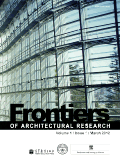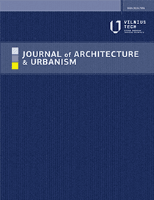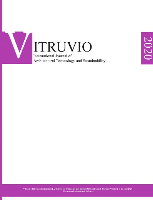
Journal of Architecture and Planning -King Saud University
Scope & Guideline
Advancing Architectural Excellence and Urban Sustainability.
Introduction
Aims and Scopes
- Architectural Design and Theory:
Focuses on advancing architectural design methodologies and theoretical frameworks, exploring how design principles can be applied in various contexts, including educational and residential settings. - Urban Planning and Development:
Investigates urban planning strategies, including smart growth and sustainable development practices, particularly within the context of Saudi cities and broader regional challenges. - Cultural and Historical Contexts:
Examines the influence of cultural heritage and historical architecture on contemporary practices, promoting a dialogue between tradition and modernity. - Technological Integration in Architecture:
Explores the role of modern technologies, such as GIS, BIM, and smart mobility, in shaping architectural practices and urban planning initiatives. - Sustainability and Environmental Design:
Addresses sustainability challenges in architecture and urban development, focusing on energy-efficient designs, sustainable materials, and the impact of architectural practices on natural resources. - Social Dynamics in Urban Spaces:
Analyzes the social implications of architectural and urban design, including accessibility, community engagement, and the spatial needs of diverse populations.
Trending and Emerging
- Integration of Artificial Intelligence in Architecture:
The rise of generative AI in design processes represents an emerging theme, showcasing how technology can inspire new architectural identities and solutions. - Sustainable Housing Solutions:
Research on low-density multifamily housing options and their effectiveness in the Saudi context indicates a growing emphasis on sustainable and innovative housing solutions. - GIS and Spatial Analysis in Urban Planning:
An increased focus on GIS applications and spatial analysis reflects a trend towards data-driven decision-making in urban planning, enhancing the understanding of spatial dynamics in cities. - Smart Technologies and Urban Mobility:
The exploration of smart technologies, including smart mobility solutions, highlights the journal's commitment to addressing contemporary urban challenges and enhancing the operational management of urban environments. - Gender and Space in Urban Design:
Emerging research on the spatial needs of working women and accessibility in urban spaces indicates a trend towards inclusivity and social equity in architectural and urban planning practices. - Post-Pandemic Design Considerations:
The impact of COVID-19 on architectural practices, particularly regarding personal space and public health, suggests a new focus on adaptive design strategies that respond to changing societal needs.
Declining or Waning
- Traditional Architectural Practices:
There is a noticeable decline in research focused solely on traditional architectural practices without integration into contemporary frameworks, indicating a shift toward more modern and innovative approaches. - Commercial and Retail Architecture:
Papers specifically addressing commercial and retail architecture have decreased, suggesting a potential waning interest in this area compared to more pressing themes such as sustainability and urban mobility. - Historical Studies without Modern Contextualization:
Research that solely examines historical architecture without linking it to current architectural practices or urban planning strategies seems to be less prevalent, indicating a potential shift towards more integrative studies. - Generic Urban Studies:
Studies that do not provide localized insights or specific case studies may be losing traction, as the journal increasingly emphasizes context-driven research that addresses unique regional challenges. - Focus on Generic Educational Methodologies:
Research focusing solely on generic educational methodologies in architecture without specific applications or innovative approaches appears to be diminishing, as there is a trend toward practical applications and technological integration.
Similar Journals

ICONARP International Journal of Architecture and Planning
Championing accessibility in architectural and planning scholarship.ICONARP International Journal of Architecture and Planning is an esteemed open-access publication that serves as a pivotal platform for fostering innovative research and discussions in the fields of architecture and urban design. Published by KONYA TECHNICAL UNIVERSITY, FACULTY OF ARCHITECTURE & DESIGN, this journal has been committed to the dissemination of high-quality academic work since 2013, promoting accessibility and global collaboration among researchers, professionals, and students. With its rigorous peer-review process and a focus on contemporary architectural and planning challenges, ICONARP seeks to contribute significantly to scholarly discourse and practical applications within the built environment. The journal is indexed in various scientific databases, enhancing its visibility and impact in the academic community. By appealing to a diverse audience, ICONARP encourages interdisciplinary studies and innovative solutions that address the complexities of modern architecture and urban living.

Architecture_MPS is a premier open-access journal published by UCL PRESS, dedicated to exploring the interconnections between architecture, urbanism, and the broader spectrum of social and cultural dynamics. Launched in 2012, this journal stands as a crucial platform for researchers, practitioners, and students alike, facilitating the exchange of innovative ideas and comprehensive scholarship in the field. With its commitment to open access, Architecture_MPS significantly enhances the visibility and accessibility of research, fostering a collaborative environment for academic discourse. The journal covers a diverse array of topics, including theoretical frameworks, policy analysis, and practical case studies, making it an invaluable resource for those engaged in the study and practice of architecture and allied disciplines. As a leading source of contemporary research, Architecture_MPS aims to bridge gaps between academia and practice, encouraging interdisciplinary dialogues that shape the future of architecture and urban studies.

Festival dell Architettura Magazine
Advancing Research in Architecture and Visual ArtsFestival dell Architettura Magazine, published by FESTIVAL ARCHITETTURA EDIZIONI, is a distinctive Open Access journal dedicated to the realms of architecture, urban studies, and the visual and performing arts. Established with a vision to foster interdisciplinary dialogue, the journal has been a part of the academic landscape since 2013 and has converged its insightful contributions from 2018 to 2023. Despite being ranked in the lower quartiles in its respective categories—Q4 in Architecture and Urban Studies, and Q3 in Visual Arts and Performing Arts—this publication remains vital for emerging researchers and seasoned professionals alike, as it provides a platform for innovative ideas and practices from Italy and beyond. It serves as a key resource for those who wish to engage with contemporary architectural thought and cultural expressions, facilitating open access to research that highlights the intersections of space, society, and art.

Frontiers of Architectural Research
Shaping the Future of Architecture Through Open ScholarshipFrontiers of Architectural Research, published by KEAI PUBLISHING LTD, stands at the forefront of interdisciplinary scholarship, addressing contemporary challenges in the fields of architecture, urban studies, building and construction, and archaeology. Since its establishment in 2012, this open-access journal has rapidly gained recognition, achieving prestigious rankings in the 2023 category quartiles, including Q1 placements in both Architecture and Archaeology. With an impressive Scopus rank of #5 out of 354 in Archaeology and #10 out of 189 in Engineering - Architecture, it demonstrates its significant influence and contribution to advancing architectural research. Frontiers of Architectural Research embraces a broad scope that fosters innovative discourse and practical solutions, catering to a diverse audience of researchers, professionals, and students keen on exploring the intersection of culture, environment, and technology. By ensuring immediate access to research findings, the journal not only enhances the visibility of scholarly work but also encourages collaborative dialogues that shape the future of architectural practice.

Journal of Architecture and Urbanism
Exploring the Intersection of Design and Urban LifeThe Journal of Architecture and Urbanism, published by VILNIUS GEDIMINAS TECH UNIV, stands as a pivotal resource for scholars and practitioners in the fields of architecture and urban studies. Since its inception in 2012, the journal has committed to advancing research and discourse on the design, planning, and functionality of urban environments, reflecting a dedicated focus on contemporary challenges in architecture and urbanism. With an impressive open access model implemented since 2018, it ensures that innovative research is accessible to a global audience, fostering collaboration and knowledge exchange. The journal boasts a commendable reputation, categorized in the Q2 quartile for Architecture and Q3 in both Geography, Planning and Development and Urban Studies as of 2023, while maintaining respectable Scopus rankings. Addressing key themes from sustainable design to socio-economic impacts on urban spaces, the journal aims to inspire new models and solutions that meet the evolving needs of growing urban populations. This is a must-read for anyone engaged in the intersection of architecture and urban development.

VITRUVIO-International Journal of Architectural Technology and Sustainability
Shaping the future of architecture through sustainable practices.Welcome to the VITRUVIO-International Journal of Architectural Technology and Sustainability, a leading open-access journal published by UNIV POLITECNICA VALENCIA, EDITORIAL UPV since 2015 and based in Spain. With its ISSN 2444-9091, this journal is dedicated to advancing the field of architectural technology and sustainability, providing a vital platform for researchers, professionals, and students alike. The journal has made significant strides in the academic landscape, achieving a Q3 ranking in Architecture and a Q4 ranking in Building and Construction for 2023. It features a diverse range of scholarly articles that explore innovative practices, cutting-edge research, and sustainable solutions in architecture. With a Scopus ranking placing it at #70/189 in Architecture and #161/223 in Building and Construction, it is positioned within the 63rd percentile and 28th percentile respectively, demonstrating its increasing impact in these vital fields. We invite you to engage with our content and contribute to the ongoing discourse around sustainability in architectural practice.

Bulletin KNOB
Unlocking the Past, Shaping the FutureBulletin KNOB, published by the KONINKLIJKE NEDERLANDSE OUDHEIDKUNDIGE BOND-KNOB, is a reputable Open Access journal that has been disseminating knowledge since 1899, with a continued commitment to making research accessible to all. Based in the Netherlands, this journal provides a platform for scholarly articles that span the fields of Conservation, History, and the Visual Arts and Performing Arts. With its 2023 Scopus rankings placing it in the top quartiles within its category, Bulletin KNOB is recognized for its significant contribution to the advancement of these disciplines. Researchers, professionals, and students alike are encouraged to engage with the journal's diverse content that bridges historical narratives with contemporary practices, fostering a deeper understanding of cultural heritage. The journal’s commitment to excellence is further reflected in its Q3 and Q4 quartile rankings, making it an essential resource for anyone dedicated to the study of the arts and humanities.

Architect
Shaping Conversations in the Architectural CommunityArchitect is a publication dedicated to the diverse and evolving field of architecture and design, presented by the reputable HANLEY WOOD, LLC. Since its inception in 1975, the journal has traversed critical periods in architecture, offering valuable insights and research that cater to both practitioners and academics alike. The journal holds a Q4 ranking in both Architecture and Visual Arts and Performing Arts, indicating its niche presence within the crowded scholarly landscape. Despite its recent rankings within the Scopus, where it lies in the lower percentiles of the architecture category, the Architect journal provides platforms for innovative discussions and explorations in design, helping to shape the discourse in the architectural community. While the journal is currently accessible via traditional subscription models, it remains a critical resource for those seeking to bridge practice and theory in architecture. As it continues to evolve beyond its historical publication periods, Architect aims to nurture a rich environment for professional growth, scholarship, and dialogue among researchers, designers, and students engaged in the dynamic world of architecture.

A + U-ARCHITECTURE AND URBANISM
Fostering Global Dialogues in Architecture and UrbanismA + U - ARCHITECTURE AND URBANISM, published by A & U PUBL CO LTD, is a prominent Japanese journal that focuses on the interdisciplinary nexus of architecture, urban studies, and the visual arts. With an ISSN of 0389-9160, this publication aims to provide a platform for innovative research and discourse in the challenging and ever-evolving landscapes of architecture and urbanism. Despite being placed in Q4 of various categories according to Scopus ranks, this journal holds significance in fostering global dialogues on urban transformations and design strategies through its diverse range of articles. The journal emphasizes not only the aesthetic dimensions of architecture but also the social and cultural implications of urban development, thereby appealing to a broad audience of researchers, professionals, and students dedicated to these fields. With a commitment to enriching the academic community, A + U serves as a vital resource for those seeking to explore and contribute to the future of urban spaces and architectural practices.

Ra-Revista de Arquitectura
Exploring new horizons in architecture and visual arts.Ra-Revista de Arquitectura is an esteemed open-access journal published by UNIV NAVARRA, SERVICIO PUBLICACIONES in Spain, dedicated to the fields of architecture and the visual arts. With an ISSN of 1138-5596 and an E-ISSN of 2254-6332, this journal aims to foster a critical dialogue among scholars, practitioners, and students by offering original research, reviews, and case studies that challenge conventional architectural paradigms and inspire innovation. Since transitioning to an open-access model in 2012, Ra has expanded its reach, allowing free access to knowledge that resonates within both academic and professional communities. Although the journal is currently ranked in Q4 in its respective categories, it remains a vital platform for emerging voices and advancements in the architecture and visual arts disciplines. Researchers can find valuable insights that push the boundaries of both theory and practice. The journal is part of a vibrant academic tradition, contributing to a deeply reflective cultural heritage, and it invites contributors from diverse backgrounds to submit their works for consideration.